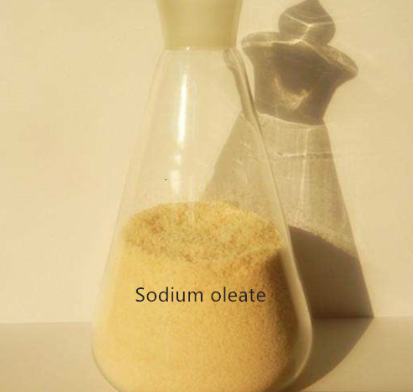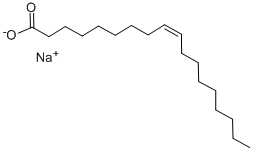Sodium Oleate: A Dual-Action Compound Enhancing Antibiotic Efficacy While Inducing Hepatotoxicity
Introduction
Sodium oleate is a kind of organic oil. It is slightly yellow or light brown-yellow coarse powder with a special taste and smell. It could be dissolved in water, alkaline soluble in ethanol, and neutral insoluble in benzene. Oleate is the main ingredient of olive oil made of soap, is the main component of tallow soap, and can also be made from sodium hydroxide and oleic acid reaction. It is a compound composed of hydrophobic and hydrophilic groups with excellent emulsifying power, permeability, detergency, and solubility in hot water. So, they are used as anionic surfactants and fabric waterproof agents. In addition, it can also be used in biological research.

Biological research
Oleic acid (C18:1) is abundant in human adipose tissue and is also present in animal and vegetable fats. Oleic acid circulating in the systemic blood in the free form has increased BBB permeability (the suggested mechanism is via albumin binding). Sztrlha and Betz examined the effects of oleic acid infusion on BBB permeability in 1991. A sodium oleate solution was injected into adult rats' right internal carotid artery (6 mL/min for 30 s), and uptake of α-aminoisobutyric acid into the brain was studied. Uptake was found to be facilitated by a 1 × 10-5 M oleic acid formulation. Interestingly and encouragingly, the effect was reversible. At 80–90 min post-injection, BBB permeability had returned to normal.
Enhancing Antibiotic Efficacy
Researchers were conducted to determine the potential effect of sodium oleate in inhibiting established biofilms of two strains, methylotrophic bacteria Methylophilus quaylei, in combination with ampicillin. The minimum inhibitory concentration (MIC) of ampicillin was determined and added in combination with sodium oleate and examined on planktonic and established biofilms of two strains of M. quaylei were characterized by different properties of cell surface hydrophobicity[1].
Their study demonstrates that sodium oleate has a promoting activity against planktonic growth of M. quaylei strains and has a slight inhibitory effect on biofilm. Adding sodium oleate enhances the bactericidal effect of ampicillin against biofilm cells. A combination of ampicillin 0.1 mg/ml (MIC) and sodium oleate 0.03 mg/ml showed a remarkable destruction effect on established biofilms.
Overall, results indicated that sodium oleate, in combination with ampicillin, enhances the inhibition of M. Quayle biofilms, and this combination can be utilized to combat bacterial biofilm resistance.
Hepatotoxicity
Li et al. observe the steatosis and inflammatory effects of L02 hepatocytes induced by different concentrations of sodium oleate. They found that with increased sodium oleate concentration, the cell viability decreased, and the cell growth inhibition rate increased. The content of triglyceride in L02 cells treated with 75, 150 and 300 μmol/L sodium oleate was significantly higher than that in the control group(P<0. 01, P<0. 001, P<0. 001), the IL-6 in the supernate was significantly higher than that in the control group(P<0. 05, P<0. 01, P<0. 001). The oil red staining showed that the lipids in the cells were accumulated after sodium oleate treatment. The expression of TLR2 in L02 cells treated with 150 and 300 μmol/L sodium oleate was significantly higher than in the control group(P<0. 05, P<0. 001). There was no significant increase in TLR4 expression after sodium oleate intervention in L02 cells. The expression of SIRT1 protein in the sodium oleate group was lower than that in the control group, and the expression of NF-κB p65 was higher than that in the control group through the Western Blot result. Therefore, L02 hepatocyte steatosis caused by sodium oleate may be associated with TLR2/NF-κB mediated inflammatory pathway[2].
References:
[1] ABIR M H A MOHAMED. Sodium Oleate Increases Ampicillin Sensitivity in Methylophilus quaylei Biofilms on Teflon and Polypropylene.[J]. Current pharmaceutical biotechnology, 2019, 20 3. DOI:10.2174/1389201020666190222191656.[2] CHEN CHEN. [Steatosis and inflammation of L02 hepatocytes induced by sodium oleate].[J]. Wei sheng yan jiu = Journal of hygiene research, 2020, 49 3. DOI:10. 19813/j. cnki. weishengyanjiu. 2020. 03. 006.
See also
Lastest Price from Sodium oleate manufacturers

US $19.00/KG2025-06-10
- CAS:
- 143-19-1
- Min. Order:
- 1KG
- Purity:
- 99.%
- Supply Ability:
- 50 ton

US $10.00-8.00/kg2025-04-21
- CAS:
- 143-19-1
- Min. Order:
- 1kg
- Purity:
- 99%
- Supply Ability:
- 10 mt


